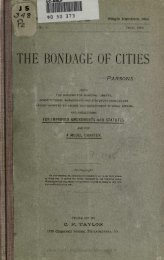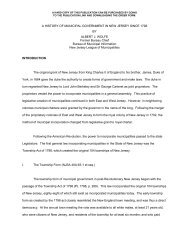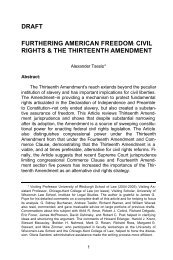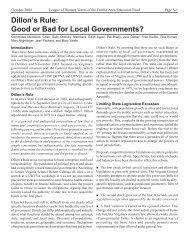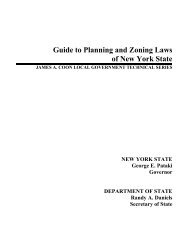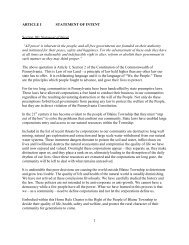The British Empire and Famine in Late 19th Century Central India
The British Empire and Famine in Late 19th Century Central India
The British Empire and Famine in Late 19th Century Central India
Create successful ePaper yourself
Turn your PDF publications into a flip-book with our unique Google optimized e-Paper software.
No. of houses per head population 0.25 0.17<br />
No. of agricultural cattle per head<br />
of population 0.43 0.31<br />
No. of cows <strong>and</strong> buffaloes per head<br />
of population 0.60 0.42<br />
No. of sheep <strong>and</strong> goats per head of<br />
population 0.08 0.11<br />
No. of carts per head of population 0.04 0.03<br />
No. of wells per head of population 0.03 0.02<br />
No. of cultivated acres head of population 5.7 3.1<br />
Source: Bas<strong>in</strong> Taluka Settlement Report, Prepared bh F.W. Francis, Director of L<strong>and</strong> Records <strong>and</strong><br />
Agriculture, Hyderabad Assigned Districts, Chikalda (April 25, 1900), p. 4.<br />
<strong>The</strong> above table is just for the taluka of Basim. However, it certa<strong>in</strong>ly suggests a trend for<br />
the period <strong>and</strong> perhaps for the prov<strong>in</strong>ce as a whole. It should be noted that Basim is a<br />
hilly jungle taluk <strong>and</strong> if the situation was decl<strong>in</strong><strong>in</strong>g <strong>in</strong> the hill districts, then <strong>in</strong> the pla<strong>in</strong><br />
districts where cultivation is more extensive, the <strong>in</strong>tensity of decl<strong>in</strong>e would be perhaps<br />
even greater. And consider<strong>in</strong>g the severity of the fam<strong>in</strong>es <strong>in</strong> the clos<strong>in</strong>g decades of the<br />
19 th century, it may well be that the st<strong>and</strong>ard of liv<strong>in</strong>g was decl<strong>in</strong><strong>in</strong>g <strong>in</strong> the entire<br />
prov<strong>in</strong>ce. For example, the number of houses per capita decl<strong>in</strong>ed along with cattle heads,<br />
carts, wells, <strong>and</strong> cultivated acreage. This certa<strong>in</strong>ly suggests an overall decl<strong>in</strong>e <strong>in</strong> the<br />
st<strong>and</strong>ard of liv<strong>in</strong>g. Decl<strong>in</strong>e <strong>in</strong> the number of wells <strong>and</strong> cultivated acres surely led to acute<br />
water <strong>and</strong> food availability decl<strong>in</strong>e throughout the prov<strong>in</strong>ce as droughts <strong>and</strong> fam<strong>in</strong>es<br />
periodically devastated the region. Widespread drought <strong>and</strong> fam<strong>in</strong>e related disasters are<br />
reported <strong>in</strong> the colonial documents for the years: 1862; 1865-66; 1868; 1871; 1875; 1878;<br />
1883-84; 1885; 1886-87; 1887-88; 1896-97; <strong>and</strong> 1899-1900 <strong>in</strong> which diseases decimated<br />
cattle <strong>and</strong> people without dist<strong>in</strong>ction. 44<br />
So even though only three fam<strong>in</strong>es were officially<br />
recognized, there were many other years when drought <strong>and</strong> fam<strong>in</strong>e conditions existed but<br />
were never recognized by the colonial state. And most of the deaths <strong>in</strong> fact took place<br />
dur<strong>in</strong>g these officially non-drought <strong>and</strong> fam<strong>in</strong>e years.<br />
15






